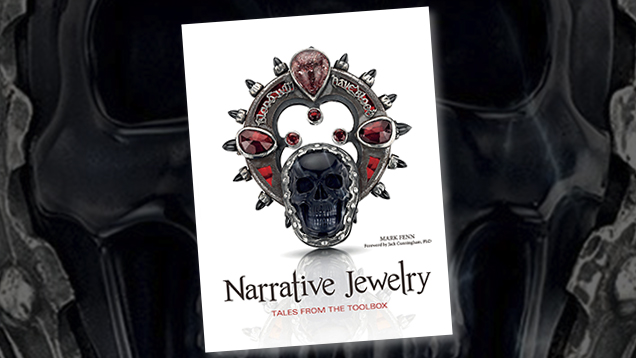Book Review: Narrative Jewelry: Tales from the Toolbox

The best jewelers know that every jewel has a story to tell. When Mark Fenn explored jewelry with a message for his dissertation at the University for the Creative Arts in England, things blossomed. The dissertation resulted in the curation of a collection of narrative jewelry for an online exhibition. His call to artists drew 350 jewelry artists from around the world who submitted 1,500 images. He narrowed these to 450 images from 241 artists. The results fill this beautiful and thought-provoking coffee-table book like a smorgasbord.
The stories contain themes as old as time, thoughts on contemporary society, and everything in between. Topics include mementos mori (symbols or reminders of death), historical reflections, feminist issues, global warming, and AIDS. Artists are arranged alphabetically with biographies, and each piece of jewelry is accompanied by the artist’s statement of meaning. It’s art as jewelry and jewelry as art, as well as jewelry as small sculpture.
The cover image, a brooch by Dauvit Alexander of Birmingham, England, is a gothic take on the kilt brooch known as a penannular. Titled “Blood Will Have Blood: A Macbeth Brooch,” its inspiration is from Act 3, Scene 4: “It will have blood, they say; blood will have blood.” Alexander, a self-taught jeweler who originally trained as a gardener, focuses on men’s jewelry. He used as a base a found, corroded iron oil tank cap and set into it polycarbonate reflector materials, faceted garnets, and strawberry quartz, with a surround of projecting black spinel points—all around the centerpiece, a carved black obsidian skull.
Melinda Risk has taken a high jewelry approach to the story of the Osmia avosetta bee, a species discovered in 1997. This bee lives a solitary life and nests in flower petals. Risk, who has a degree in jewelry from Kent State University, has created the bee’s story in a beautiful ring, the “Osmia Avosetta Bee Ring.” The bee image is back-carved into a Rose de France amethyst bezel set in 22K gold. Surrounding the center are small round diamonds set flush into the oxidized sterling shank. Down one side of the shank is a field of flowers with round pink sapphires in each one, while on the other side of the shank is a raised drawing of a bee. As a crowning touch, crushed dried flower petals are set beneath the center stone.
The jewelry design of Helen Noakes of Salisbury, England, is represented by two pieces: a bangle bracelet and a pendant, both executed in resin and silver. “Quantum Leap,” a whimsical pendant, depicts three tigers jumping through a “hoop” of clear resin bounded by silver, the first and last tigers half in and half out of the hoop. “Solo Voyager” features a tiny plastic scale-model polar bear trapped in an icy-looking resin bangle. She means it as a commentary on the disappearing habitat of the bear. She calls herself something of a choreographer, placing figures in the scenarios she creates.
Fenn has included his own work in this collection, a trio of sterling brooches done in a variety of processes. They are memento mori pieces, and here they deal with his sense of grief over losses. Fenn bases these brooches on the Bible’s apocalyptic Book of Revelation (6:8: “…behold a pale horse…”). While a heavenly sense of a floating city pervades all three, they each tell a particular story, two with horses and one with a robed ghostly figure.
Rudee Tancharoen of Thailand takes a conceptual approach to her silver jewelry. “Armonia” is a pair of mismatched silver earrings. One is a vertical black cylinder on a silver hook, while the other features three wire circles on a darker hook, loosely attached in a triangular configuration with jump rings. These spare earrings have their genesis in Tancharoen’s thoughts about politics in these times. “A pair doesn’t need to be identical.…simply being together peacefully with or without harmony is the key.”
This is a sturdy, easy-to-navigate book. Fenn has done a wonderful job of including many different approaches, materials, and themes from artists from all over the world. Traditionally, many artists refrain from telling you exactly what their art is about, preferring to let the viewer have his or her own experience. But in this book most artists give the viewer a leg up on understanding work that might be inaccessible for some. For those who love sculpture, it is a way into the very small sculptures that are the jewels in this book. For lovers of fine traditional jewelry, this is an entrée to another way to think about jeweled adornment. This one will stay on its owners’ coffee tables.



